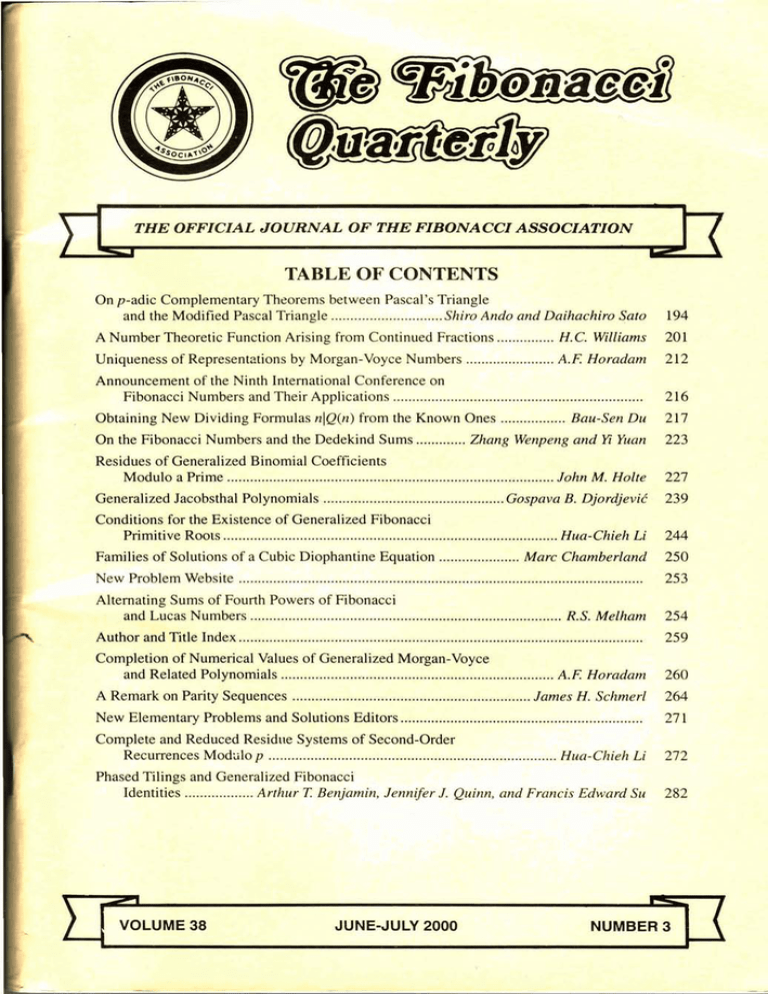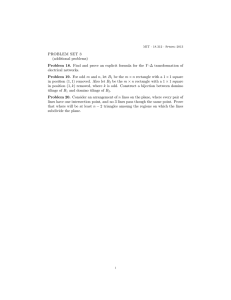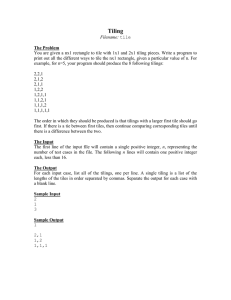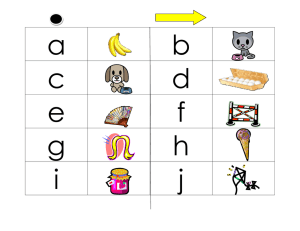PDF file - Harvey Mudd College Department of Mathematics
advertisement

THE OFFICIAL JOURNAL OF THE FIBONACCI ASSOCIATION
TABLE OF CONTENTS
On p-adic Complementary Theorems between Pascal's Triangle
and the Modified Pascal Triangle .............................Shiro Ando and Daihachiro Sato
A Number Theoretic Function Arising from Continued Fractions ............... H.C. Williams
194
201
Uniqueness of Representations by Morgan-Voyce Numbers .......................A.E Horadam
212
Announcement of the Ninth International Conference on
Fibonacci Numbers and Their Applications .................................................................
Obtaining New Dividing Formulas nlQ(n) from the Known Ones .................Bau-Sen Du
On the Fibonacci Numbers and the Dedekind Sums ............. Zhang Wenpeng and Yi Yuan
Residues of Generalized Binomial Coefficients
Modulo a Prime ..................................................................................... John M. Holte
Generalized Jacobsthal Polynomials ........................................ Gospava B. DjordjeviC
Conditions for the Existence of Generalized Fibonacci
Primitive Roots ....................................................................................... Hua-Chieh Li
Families of Solutions of a Cubic Diophantine Equation ..................... Marc Chamberland
d N e w Problem Website .........................................................................................................
Alternating Sums of Fourth Powers of Fibonacci
and Lucas Numbers ................................................................................. R.S. Melham
Author and Title Index .........................................................................................................
Completion of Numerical Values of Generalized Morgan-Voyce
and Related Polynomials ....................................................................... A.E Horadam
A Remark on Parity Sequences .............................................................. James H. Schmerl
216
217
223
227
239
244
250
253
254
259
260
264
New Elementary Problems and Solutions Editors ..............................................................
Complete and Reduced Residue Systems of Second-Order
Recurrences Mod-<lop ...........................................................................
.XU-Chieh Li
272
Phased Tilings and Generalized ~ibonacci&&&&
Identities .................. Arthur T. ~ e n j a k i nJennifdr
,
J. Quinn, and Francis Edward Su
282
JUNE-JULY 2000
PHASED TILINGS AND GENERALIZED FIBONACCI IDENTITIES
Arthur T. Benjamin
Dept. of Mathematics, Harvey Mudd College, Claremont, CA 91 71 1
benjarnin@hmc.edu
Jennifer J. Quinn
Dept. of Mathematics, Occidental College, Los Angeles, CA 9004 1
jquinn@oxy.edu
Francis Edward Su
Dept. of Mathematics, Harvey Mudd College, Claremont, CA 9 17 1 1
.su@nath.hmc.edu
(SubmittedAugust 1998-Final Revision Mqy 1999)
1. INTRODUCTION
Fibonacci numbers arise in the solution of many combinatorial problems. They count the
number of binary sequences with no consecutive zeros, the number of sequences of 1's and 2's
which sum to a given number, and the number of independent sets of a path graph. Similar interpretations exist for Lucas numbers. Using these interpretations, it is possible to provide combinatorial proofs that shed light on many interesting Fibonacci and Lucas identities (see [I], [3]). In
this paper we extend the combinatorial approach to understand relationships among generalized
Fibonacci numbers.
Given Go and G, , a generalized Fibonacci sequence Go, G,, G,, ... is defined recursively by
Gn = Gn-, + GP2 for n 2 2. Two important special cases are the classical Fibonacci sequence Fn
(Fo = 0 and 4 = 1) and the Lucas sequence Ln (Lo= 2 and L, = 1).
These sequences satisf) numerous relationships. Many are documented in Vajda [6], where
they are proved by algebraic means. Our goal is to recount these identities by combinatorial
means. We introduce several combinatorial techniques which allow us to provide new proofs of
nearly all the identities in [6] involving generalized Fibonacci numbers. We show that in the
fiarnework of phased tilings, these identities follow naturally as the tilings are counted, represented, and transformed in clever ways. These techniques are developed in the next several
sections. In the final section, we discuss possible extensions.
t
2. COMBINATORIAL INTERPRETATION
Recall that F, counts the number of sequences of 1's and 2's which sum to n. Equivalently,
F,, counts the number of ways to tile a 1xn rectangle (called an n-board consisting of cells
labeled 1, ...,n) with 1 x 1 squares and 1 x 2 dominoes. For combinatorial convenience, we define
6. = F,,, . Then fn is the number of ways to tile an n-board with squares and dominoes.
When Go and GI are nonnegative integers, we shall obtain an analogous combinatorial interpretation of the generalized Fibonacci numbers Gn. Define a phased n-tiling to be a tiling of an
n-board by squares and dominoes in which the last tile is distinguished in a certain way. Specific.ally, if the last tile is a domino, it can be assigned one of Go possible phases, and if the last tile is
a square, it can be assigned one of GI possible phases. For example, when Go = 5 and G, = 17,
there are G, = 39 phased tilings of length 3 as follows: There are 5 of the form (square, phased
domino); 17 of the form (domino, phased square); and 17 of the form (square, square, phased
PHASED TILINGS AND GENERALIZED FIBONACCI IDENTITIES
.. .
square). In general, let go= Go, gI= G,, and, for n 2 2 , let gn count the number of phased
n-tilings. By conditioning on whether the first tile is a square or domino, we obtain the identity
gn= gn-I+gn-, for n 2 2. Hence, gn= Gn,giving the desired interpretation.
This combinatorial definition can be extended to n = 1 and n = 0. Clearly G, counts the number of phased I-tilings. It will be convenient to assign the "last" tile of a 0-board one of the Go
domino phases.
Notice when there exists only one domino phase and only one square phase, we recover our
original interpretation of fn .
Previous interpretations of the Lucas numbers Ln (see [I], [4], [5]) counted the number of
ways to tile a "circular" n-board by squares or dominoes. Since Lo = 2 and L, = 1, a phased
n-board tiling can end with a phase one domino, a phase two domino, or a phase one square. In
all three cases, the corresponding circular n-board tiling arises by first gluing cells n and 1
together. Tilings that end in a phase two domino are then rotated one cell to obtain a circular
tiling with a domino covering cells n and 1.
3. ELEMENTARY IDENTITIES
Before launching into more sophisticated techniques, we demonstrate how our combinatorial
interpretation of Gn yields quick proofs of some basic identities. For instance, by conditioning on
whether the last tile is a phased domino or a phased square, we immediately obtain, for n 2 2,
Gn = GoL-2 + GJ,-I
More identities are obtained by conditioning on other events. Consider
The right-hand side of this equality counts all phased (n + 2) -tilings containing at least one domino (there are G, phased tilings consisting of all squares). The left-hand side is obtained by
conditioning on the position of the first domino. If the first domino covers cells n - k + 1 and
n - k + 2 (0 5 k 5 n), then the preceding cells are covered by squares and the remaining cells can
be covered Gk ways.
Similarly, there are G2, - Go phased 2n-tilings with at least one square. By conditioning on
the position of the first square, we obtain
fi
n
Iden tity 2 waj& (34)J:
= G,. - Go.
G,
k=l
A phased (2n+ I) -tiling must contain a first square, which leads to
Identity 3 [Vajda (35)]: GI +
n
GZk= G2,,+,.
k=l
The G, term on the left-hand side counts those boards that begin with n dominoes followed by a
phased square.
To prove
Identity 4 [Vajda (a)]= Gm+,= fmGn+ fm-lGn-l,
PHASED TILINGS AND GENERALIZED FIBONACCI IDENTITIES
we consider whether or not a phased (m + n) -tiling can be separated into an (unphased) m-tiling
followed by a phased n-tiling. There are fmGntilings breakable at cell m. The unbreakable tilings
must contain a domino covering cells m and m+ 1; the remaining board can be covered f,-,Gn-,
ways.
4. BINOMIAL I D E N T r n S
Vajda contains several identities involving generalized Fibonacci numbers and binomial coefficients. All of these are special cases of the following two identities.
P
Zakntity 5 [Vajda (46)]: G,
=
i=O
)(:
G,
.
When n 2 p, Identity 5 counts phased (n+p)-tilings by conditioning on the number of dominoes that appear among the first p tiles. Given an initial segment of i dominoes and p - i squares,
(p) counts the number of ways to select the i positions for the dominoes among the first p tiles.
G,,-, counts the number of ways the remaining n - i cells can be given a phased tiling.
Identity 6 can be seen as trying to break a phased (m + (t + 1)p)-tiling into p unphased segments of length t followed by a phased remainder. The first segment consists of the tiles covering
cells 1 through ji, where ji = t if the tiling is breakable at cell t and j, = t + 1 otherwise. The next
segment consists of the tiles covering cells j, + 1 through jl + j2, where j2= t if the tiling is
breakable at cell jl + t and j2= t + 1 otherwise. Continuing in this fashion, we decompose our
phased tiling into p tiled segments of length t or t + 1 followed by a phased remainder of length at
least m. Since the length t + 1 segments must end with a domino, the term (f) f,'f,T'GHi counts
the number of phased (m + (t + 1)p)-tilings with exactly i segments of length t.
5. SIMULTANEOUS TILINGS
Identities involving squares of generalized Fibonacci numbers suggest investigating pairs of
phased tilings. The right-hand side of
+
In
Identity 7 [Vajda (3911:
Gi-,Gi = G;,, - Gi
i=l
counts ordered pairs (A, B) of phased 2n-tilings, where A or B contains at least one square. To
interpret the left-hand side, we define the parameter kx to be the first cell of the phased tiling X
covered by a square. If X is all dominoes, we set kx equal to infinity. Since, in this case, at
least one square exists in (A, B), the minimum of kA and kg must be finite and odd. Let k =
min{kA,kB + 1). When k is odd, A and B have dominoes covering cells 1 through k - 1 and A has
a square covering cell k. Hence, the number of phased pairs (A, B) with odd k is G2n-kG2n-k+l.
When k is even, A has dominoes covering cells 1 through k and B has dominoes covering cells 1
through k - 2 with a square covering cell k - 1. Hence, the number of phased pairs (A, B) with
. Setting i = 2n + 1- k gives the desired identity.
even k is also GZn-kG2,,-k+,
Similarly, the next identity counts ordered pairs of phased (2n+ 1)-tilings that contain an
unphased square. Conditioning on the first unphased square yields
PHASED TILINGS AND GENERALIZED FIBONACCI IDENTlTIES
2n+l
,
Identity 8 [Vajda (41)J:
G, = G:,,+, - G:
.
i=2
In the same spirit, our next identity conditions on the location of the first domino in a pair of
phased tilings.
cGi-IGi+2= G:+, - G: .
n
Zdentity 9 [Vajda (43)J:
i=l
The right-hand side counts the number of pairs (A, B) of phased (n+ 1)-tilings, where A or B
contains at least one domino. Here we define the parameter lx to be the first cell of the phased
tiling X covered by a domino. If X is all squares, we set ex equal to infinity. Let 'k = min{lA,tB).
The number of phased (n + 1)-tiling pairs (A, B), where the .!?' cell of A is covered by a domino
, 3,-,
and the number of such pairs where the P" cell of A is covered by a square is
is G&
Gn-,,Gn-,.
This implies
Substituting G
,,
for Gpf+2+Gn-,+, and letting i = n - .t+ 1 yields the desired identity.
6. A TRANSFER PROCEDURE
The identities proved in this section all take advantage of the same technique. Before proceeding, we introduce helpfbl notation. For m 2 0, define %, to be the set of all phased m-tilings
with Go domino phases and Gl square phases. An element A E %, created fiom a sequence of el
dominoes, e, squares, e, dominoes, ..., and ending with a phased tile can be expressed uniquely as
A = de1Se2d%se4
--.def-lfip,where p represents the phase of the last tile. All exponents are positive except that el or e, may be 0, and 2e1+ e, + 2% + e, + + 2e,,, + e, = m . When e, = 0, the
last tile is a domino and p E (1, ..., Go); when e, 2 1, the last tile is a square and p E (1, ..., GI).
Likewise, for n 2 0, define Xn to be the set of all phased n-tilings with Ho domino phases and Hl
square phases. Notice that the sizes of %, and Xn are G, and Hn, respectively.
We introduce a transfer procedure T to map an ordered pair (A, B) E%, x Xn to an ordered
where 1I m I n . T has the effect of shrinking the smaller tiling and
,
x
pair (A', B') E, %
growing the larger tiling by one unit. For such a pair (A, B), define k = min{k,, k,) ,the first cell
in A or B that is covered by a square. If the k' cell of A is covered by a square and 1< k _< m - 1,
then we transfer that square from A to the k' cell of B. Formally, before the transfer, we have
A = d(k-1)12sa,B = dck-')I2b, where a E %,-k, b E Xn-k+l. The transfer yields A' = dck-llt2a,
B' = d(k-1)12sb.If the k"' cell of A is covered by a domino and 1I k 5 m - 2 , then we exchange
that domino with the square in the k' cell of B. Formally, before the exchange, A = d(k+1)'2a,
B = d(k-1)'2sb,where a E %,k-l, b E Xn,k . The exchange yields A' = d(k-1)12sa,B' = dck+llt2b.
We abbreviate this transformation by T(A, B) = (A', B'). Notice that our rules do not allow for a
phased tile to be transferred or exchanged.
Lemma I : For 1< m ,< n, T establishes an almost one-to-one correspondence between %, x X,
. The difference of their sizes satisfies .
and %,-1 x
PHASED TILINGS AND GENER4LUED FIBONACCI IDENTITIES
Proofi ' ~ o t i c that
e when T is defined, T(A, B) has the same k value as (A, B), which makes
T easy to reverse. It remains to enumerate (A, B) €93, x X, for which T is undefined and
x Glthat do not appear in the image of T.
(Af,B') E
When m is odd, T is undefined whenever k = m. Here A = d("')I2a, B = d("l)I2b, where
a E YIl, b E X,
. Hence, the domain of T contains GmHn- GIHn-,,,+Ielements. The elements
of, ,% x X,,+, that do not appear in the image of T have k 2 m and are therefore of the form
A' = d(*l)12p, B' = d(m-1)12b',
where p E (1, ...,Go), bf E %en-,+, . Hence, the image of T consists
of Gm-1%1- GoH,,+,
elements. Since T is one-to-one we have, when m is odd,
GmHn - GlHn-,+I = Gm-lHn+l- GoHn-m+2.
When m is even, T is undefined whenever k 2 m and sometimes undefined when k = m - 1.
Specifically, T is undefined when A = d"/2p, B = d(m-2)'2b,where p E {I, ..., Go), b E
,+, ,%e
.
Hence, the domain of T contains G,,,Hn- GoH,,,
elements. The elements of %,-, x X,,,, that do
not appear in the image are of the form A' = d("-2)'2af, B = dm"b', where a' E %,, br E X
,, .
Hence, the image of T consists of Gw1H,, - G,H,
elements. Thus, when m is even, we have
We specialize Lemma 1 by setting m = n and choosing the same initial conditions for %, and
X,, to obtain
Identity 10 r a j a (28)]: G,,G,, - G: = (- l)"(G: - G0G2).
Alternately, setting G, = F, and evaluating lemma 1 at m + 1, we obtain
Identity 1I [Vajda (9)J.- H,
= (-1)"(FmlHn - F s W 1 )for 05 m I n .
A slightly different transfer process is used to prove
Identity 12 [Vajda (1Oa)]: G,
+ (- l)'"G,,
= LmGnfor 0 Im s n.
We construct an almost one-to-one correspondence fiom 2, x%, to %+,,
where 2,
denotes the set of Lucas tilings of length m. Let (A, B) €3,x %., If A ends in a (phase 1)
square or a phase 1 domino, then we simply append A to the front of B to create an (m + n) -tiling
that is breakable at m. Otherwise, A ends in a phase 2 domino. 1n'this case, before appending A
to the fi-ont ofB, we transfer a unit fiom B to A by a similar process. (If the first square occurs in
B, then transfer it into the corresponding cell of A. Otherwise, the first square of A is exchanged
with the corresponding domino in B.) This creates a tiling of %,+, that is unbreakable at m.
When m is even, the transfer is undefined for the Gn-, elements of 3, x %, where A contains
only dominoes, ending with a phase 2 domino, and B begins with m /2 dominoes. Otherwise, the
transfer is one-to-one and onto %,+,. When m is odd, the transfer is always defined but misses
the G,,, elements of %+,
that begin with m dominoes. Identity 12 follows.
A similar argument establishes
Identity 13 [Vajda (1Ob)]: G,
- (-l)"Gn,
= Fm(Gn-l+ Gn+l)for 0 I m 5 n.
The transfer process T can be refined to allow us to shrink and grow pairs of phased tilings by
more than one unit. Specifically, we construct an almost one-to-one correspondence between
$4, x En and
x X,,+h,where 1 I h 2 m - 1< n. Let 3;, denote the set of (unphased) n-tilings.
PHASED ~ M G AND
S GENERALIZED FIBONACCI IDENTITIES
1 = fn. ' ~ i v e n(A, B) E %, x Xn, define a transfer process T, as follows: If A is breakable at
So
then we append segment a, to the beginning of
cell h, i.e., A =al%, where a, E ghand a, E%,,,-~,
B. That is to say, &(A, B) = (A', B'), where A' = a, and B' = alB. If A is unbreakable at cell h,
i.e., A = a 1 4 , where a, ~ ? f ~and- ~a,
then let (A", B") = T(&, B) and (A', B') =
(A, a1Bw). Notice that B , when defined, will necessarily begin with a domino and, therefore, B'
will be unbreakable at h.
Discrepancies in T, mapping %, x Xn to %,-h x X,,+h,are proportional (by a factor off,,)
Hence, for 1 Ih Im - 1, Lemma
to the discrepancies in T mapping %,-h+l x & to %,,,-hX
1 implies
G f l n - G m - f l n + h = ( - l ) w h + l f k l ( G ~ h +-, GIHm-nh) (I)
Notice that f,lHn-,+h+l counts the number of phased (n = m+ 2h)-tilings that are breakable at
h- 1. Hence, f,,Hn-,+,,
= Hn-m+2h
- fh-2Hn-m+h.Similarly, fh-,G1 = Gh - fh-,Go. So equation
(1) can be rewritten as
Reindexing, this is equivalent to
Identity 14 pajda (18)) Gn+hHn+k
- G,,H,,+h+k= (- l)n(GhHk- GOHkk).
This identity is applied, directly or indirectly, by Vajda to obtain identities (19a) through (32).
7. BINARY SEQUENCES
There are identities involving generalized Fibonacci numbers and powers of 2. This leads us
to investigate the relationship between binary sequences and Fibonacci tilings.
A binary sequence x = xlx,.. .xn can be viewed as a set of instructions for creating a Fibonacci tiling of length less than or equal to n. Reading x fiom left to right, we interpret 1's and 01's
as squares and dominoes, respectively. The construction halts on encountering a 00 or the end of
the sequence. For example, 111010110101 represents the 12-tiling s?d2sd2, 1110101110 represents the 9-tiling 3d2?, and 0 111001011 represents the 4-tiling a!?. Binary sequences that begin
with 00 denote the O-tiling.
Given n, tilings of length n and n - 1 are represented uniquely b i binary sequences of length n
that end with a 1 or 0, respectively. For k S n- 2, a k-tiling is represented by 2n-k-2 binary
sequences of length n since the first k +2 bits are determined by the k-tiling followed by 00; the
remaining n - (k + 2) bits may be chosen freely. This yields the following identity:
n-2
fn
+fn-l +
fk
zn-*"
= 2".
k=O
By dividing by Zn, reindexing, and employing f,, = fn
Identity 15 [Vajda (3 7a)]:
+f,,,
we obtain
2=zkb= 1~--.2"
fn+t
k-2
The same strategy can be applied to phased tilings. Here, for convenience, we assume the phase
is determined by the first tile (rather than the last). The phased identity corresponding to equation
(2) is
PHASED TILlNGS AND GENERALIZED FIBONACCI U)ENTlTrES
The right-hand side counts the number of ways to select a length n binary sequence x and a phase
p. From this, we construct a length n + 1 binary sequence. Ifp is a domino phase, construct the
sequence Ox; ifp is a square phase, construct the sequence lx. Interpret this new n + 1-sequence
as a Fibonacci tiling in the manner discussed previously, and assign the tiling the phase p. By construction, the phase is compatible with the first tile. (Recall that empty tilings are assigned a
domino phase.) A phased tiling of length n+ 1 or n has a unique (x, p) representation. For
0 5 k S n - 1, a phased k-tiling has 2n-k-1representations. This establishes equation (3). Dividing
by 2" gives
8. DISCUSSION
The techniques presented in this paper are simple but powerful--counting phased tilings
enables us to give visual interpretations to expressions involving generalized Fibonacci numbers.
This approach facilitates a clearer understanding of existing identities, and can be extended in a
number of ways.
For instance, by allowing tiles of length 3 or longer, we can give combinatorial interpretation
to higher-order recurrences; however, the initial conditions do not work out so neatly, since the
number of phases that the last tile admits do not correspond with the initial conditions of the
recurrence.
Another possibility is to allow every square and domino to possess a number of phases,
depending on its location. This leads to recurrences of the form xn = anxn-,+ bnxn-, . The special
case where bn = 1 for all n provides a tiling interpretation of the numerators and denominators of
simple finite continued fractions and is treated in [2].
ACKNOWLEDGMENT
The authors gratehlly acknowledge the anonymous referee for many valuable suggestions.
* .
REFERENCES
1. A. T. Benjamin & J. J. Quinn. "Recounting Fibonacci and Lucas Identities." College Math.
J. (to appear).
2. A. T. Benjamin, J. J. Quinn, & F. E. Su. "Counting on Continued Fractions."- Preprint.
3. R. C. Brigham, R. M. Caron, P. Z. Chinn, & R. P. Grimaldi. "A Tiling Scheme for the Fibonacci Numbers." J. Recreational Math. 28.1 (1996- 1997):10-16.
4. L. Comtet. Advanced Combinatorics: The ~ roft Finite a& ~nfiniteExpansions. Dordrecht:
D. Reidel, 1974.
5. H. Prodinger & R. F. Tichy. "Fibonacci Numbers of Graphs." The Fibonacci Quarterly 20.1
(1982): 16-21.
6. S. Vajda. Fibonacci and Lucas Numbers, and the Golden Section. New York: Wiley, 1989.
AMS Classification Numbers: 05A19, 11B39



